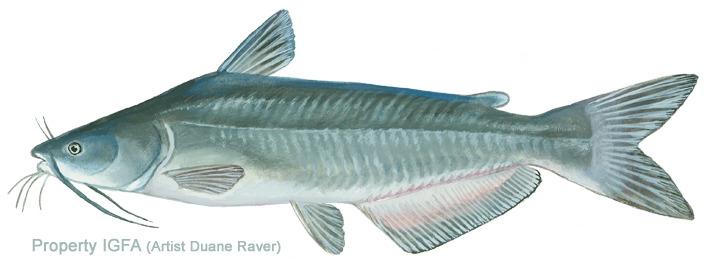Game Fish Identification Reference Guides
Catfish, channel
(Ictalurus punctatus)
(Ictalurus punctatus)

(Rafinesque, 1818); ICTALURIDAE FAMILY
The channel catfish is currently distributed through most of the U.S. and parts of southern Canada and northern Mexico. In the U.S. it is most abundant in the central part of the country east to the Appalachians. Its occurrence is sparser and mostly by introduction along the west coast and east of the Appalachians.
Channel catfish prefer clean bottoms of sand or gravel in larger lakes and rivers. They feed mainly on crayfish, fishes, and insects generally at night in swifter moving currents. At spawning time they will enter and ascend small tributaries and streams.
The distinctive channel catfish can often be recognized at a glance by its deeply forked tail and spots on the body (though not all specimens have them). The only other catfish with forked tails occurring in U.S. waters are the blue catfish (Ictalurus furcatus) and the white catfish (Ameiurus catus), neither of which is ever spotted.
In addition to the spotted specimens, some channel catfish may be entirely black dorsally (males during the spawning season), or dark blue without spots, or even uniformly light blue or silvery exactly like a blue catfish or white catfish. In the latter cases, the species can be identified by the number of rays in the anal fin. White catfish have 19 23 rays, channel catfish have 24 30, and blue catfish have the longest anal fin with 30 36 rays. Internally, the channel catfish has two chambers in the swim bladder and the blue catfish has three.
The channel catfish is very highly regarded for its food and sports value, and is reared commercially and transported throughout the country
The channel catfish is currently distributed through most of the U.S. and parts of southern Canada and northern Mexico. In the U.S. it is most abundant in the central part of the country east to the Appalachians. Its occurrence is sparser and mostly by introduction along the west coast and east of the Appalachians.
Channel catfish prefer clean bottoms of sand or gravel in larger lakes and rivers. They feed mainly on crayfish, fishes, and insects generally at night in swifter moving currents. At spawning time they will enter and ascend small tributaries and streams.
The distinctive channel catfish can often be recognized at a glance by its deeply forked tail and spots on the body (though not all specimens have them). The only other catfish with forked tails occurring in U.S. waters are the blue catfish (Ictalurus furcatus) and the white catfish (Ameiurus catus), neither of which is ever spotted.
In addition to the spotted specimens, some channel catfish may be entirely black dorsally (males during the spawning season), or dark blue without spots, or even uniformly light blue or silvery exactly like a blue catfish or white catfish. In the latter cases, the species can be identified by the number of rays in the anal fin. White catfish have 19 23 rays, channel catfish have 24 30, and blue catfish have the longest anal fin with 30 36 rays. Internally, the channel catfish has two chambers in the swim bladder and the blue catfish has three.
The channel catfish is very highly regarded for its food and sports value, and is reared commercially and transported throughout the country













